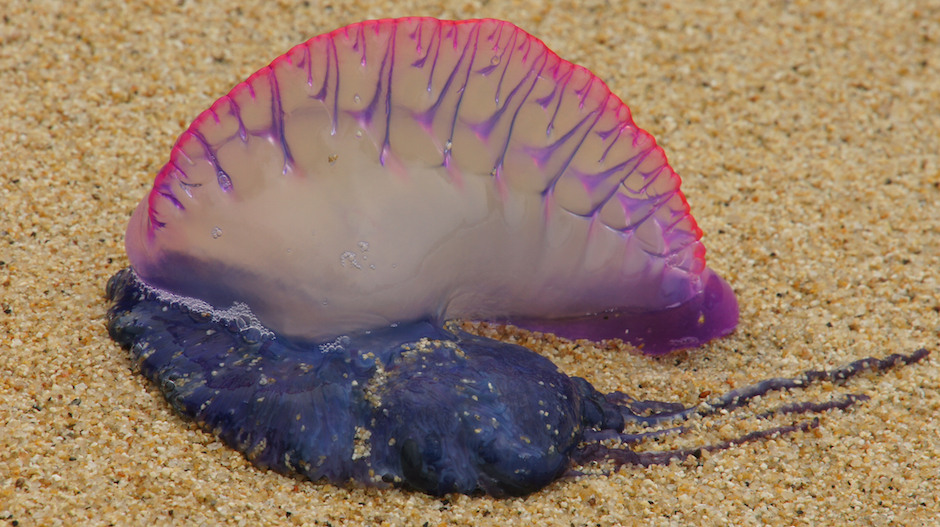I Came Face-to-Face With a Man-of-War Jellyfish in Atlantic City Yesterday
While walking north on the Atlantic City beach on Tuesday afternoon, I came across a rather frightening sight: No, not Donald Trump in a Speedo — a Portuguese man-of-war jellyfish.
I was walking very close to the water, so waves occasionally came up and wet my legs to my knees. And when one such wave came toward the shore, it brought with it the scary-looking jellyfish. Had my friend not pulled me out of the way, I probably would have stepped on it. I’m glad I didn’t.
The Portuguese man-of-war has been nicknamed the “floating terror,” and for good reason. The stings that the man-of-war delivers are extremely painful and can even cause death in rare cases.
“In many cases, they have tentacles that are 100-feet long,” says Paul Bologna, director of the Marine Biology and Coastal Sciences Program at New Jersey’s Montclair State University. “And if you get wrapped up in one, if the arms engulf you and you get a massive dose, you can be killed. They’re meant to kill things.”
Fortunately, says Bologna, the man-of-war I saw on the beach in Atlantic City wouldn’t kill anyone, because, like most of the men-of-war that wash up on the shore, the dangerous tentacles had been shredded apart by the rough surf. (The man-of-war I saw looked almost identical to the one seen here. Unfortunately, my phone was dead, so I couldn’t take a picture.)
“But you can still get an incredibly painful sting,” he cautions. “Even if it’s dead. The stinging cells are still viable.”
I’ve been going to the Jersey Shore for a long, long time, and I don’t ever remember seeing a man-of-war before. But in June, a washed-up man-of-war terrorized the Long Beach Island beach town of Harvey Cedars. And there have been other shore sightings as well, as chronicled on the new Facebook group New Jersey Jellyspotters.
If you come across a man-of-war, don’t go anywhere near it. Should you get stung, wash the area thoroughly with salt water. “Never fresh,” insists Bologna. “Fresh water will cause any remaining sting cells to explode.” After that, douse the area with vinegar. “It doesn’t help with the pain,” says Bologna. “But what it does do is immobilize any stinging cells that haven’t fired. It makes them so that if you still have them, they won’t continue to sting you.”
So why are these unwelcome guests suddenly turning up on the beach, just when we’re starting to relax into summer?
“These are tropical and subtropical creatures,” explains Bologna, who has been collecting DNA to determine exactly where these jellyfish originated. “But they get caught up in the Gulf Stream and pulled into the Atlantic and continue to trek northward. And then, if the winds are just right, they’ll be blown toward the shore. We’ve had a lot of easterly and northeasterly winds over the last month. Really, perfect conditions. And then the tide helps bring them in closer.”
And it doesn’t sound like the man-of-war invasion at the Jersey Shore is going to be over anytime soon. There have been sightings on Delaware beaches. And Bologna points out that they washed up on a beach in North Carolina a few days ago, adding, “And if they’re washing up there, there’s a high probability that there are many off our coastline.”
Great. Suddenly the Poconos are starting to look a whole lot more appealing.
Follow @VictorFiorillo on Twitter.



